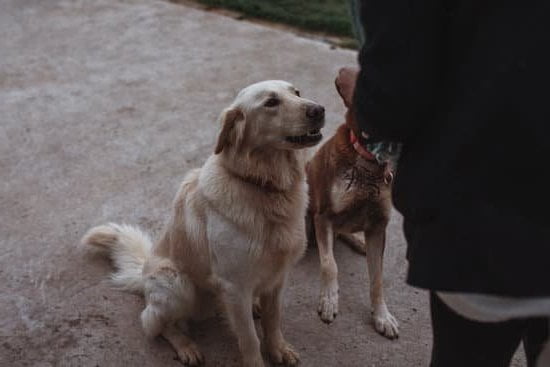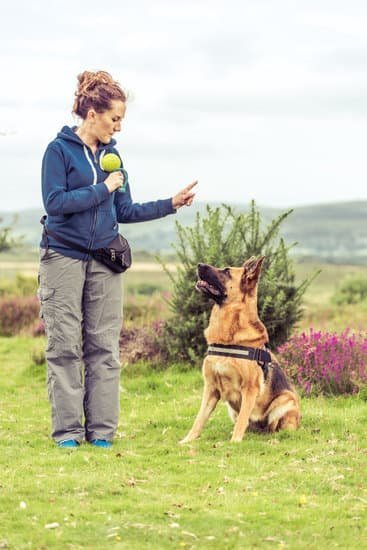Can i train my dog to pee in the toilet? Many dog owners have asked themselves this question, wondering if it is possible to teach their furry companions to use the toilet instead of going outside or on a traditional pee pad. In this article, we will explore the benefits and challenges of training your dog to pee in the toilet, as well as provide a comprehensive guide on how to successfully accomplish this feat.
The idea of teaching a dog to use the toilet may seem far-fetched, but with the right methods and commitment, it is indeed possible. Not only can it eliminate the need for frequent outdoor potty breaks and messy cleanup of pee pads, but it can also be a convenient solution for pet owners living in apartments or urban areas without easy access to outdoor spaces.
However, toilet training your dog also comes with its own set of challenges, such as assessing your dog’s suitability for this type of training and addressing potential setbacks during the process.
In the following sections, we will delve into the science behind dog toilet training and discuss key factors to consider before starting the training process. Additionally, we will provide a detailed guide on methods and techniques for toilet training your dog, as well as highlight common mistakes to avoid and offer solutions for troubleshooting any issues that may arise during the training journey.
So if you’ve ever wondered “Can I train my dog to pee in the toilet?” then read on to discover all you need to know about this unique aspect of pet care.
The Science Behind Dog Toilet Training
The concept of training a dog to pee in the toilet may seem far-fetched to some, but there is actually science behind this training method. Understanding the reasons why dogs can be trained to use a toilet can provide insight into the effectiveness and feasibility of this training approach.
Instinctual Behavior
Dogs have an instinctual desire to keep their living spaces clean, which makes them open to learning new bathroom habits. In the wild, dogs would naturally seek out areas away from their sleeping and eating areas to relieve themselves. This instinct can be leveraged by teaching them that the toilet is their designated bathroom spot.
Imitating Human Behavior
Another reason why dogs can be trained to pee in the toilet is that they are highly adaptable and capable of imitating human behavior. Dogs are known for mimicking their owners’ actions, and with consistent training and reinforcement, they can learn to associate the toilet with the act of eliminating waste.
Cognitive Ability
Furthermore, dogs have a level of cognitive ability that enables them to learn complex tasks. Through positive reinforcement and consistent training methods, dogs can be taught to understand and respond to cues related to using the toilet. This cognitive capacity supports the notion that dogs are capable of being trained to pee in the toilet.
Understanding these underlying factors provides dog owners with more confidence in undertaking the task of toilet training their pets. By recognizing that there is scientific reasoning behind this training method, owners can approach the process with realistic expectations and determination.
Assessing Your Dog’s Suitability for Toilet Training
When it comes to toilet training your dog, it’s important to assess whether your furry friend is actually suitable for this type of training. Not all dogs may be able to adapt to using the toilet, so it’s essential to consider various factors before embarking on this training process.
Age and Health
One key factor to consider is your dog’s age and overall health. Younger, more agile dogs may find it easier to learn the toilet training process compared to older or physically limited dogs. Additionally, if your dog has any medical conditions that affect their bladder control or mobility, toilet training may not be a feasible option.
Temperament
Another important aspect to consider is your dog’s temperament. Dogs that are anxious or easily stressed may struggle with the concept of using a new elimination area, such as a toilet. It’s crucial to evaluate whether your dog has the right temperament and confidence for this type of training.
Previous Training Experience
If your dog has successfully undergone previous obedience or house training, they may be more receptive to learning how to use the toilet for their bathroom needs. Dogs with a history of quick learning and adaptability in training scenarios can often transition more smoothly into toilet training.
Assessing these key factors can help you determine whether your dog is a good candidate for toilet training. By considering their age, health, temperament, and previous training experience, you can make an informed decision about whether or not to proceed with teaching your dog to pee in the toilet.
Steps to Train Your Dog to Pee in the Toilet
Training your dog to pee in the toilet can be a challenging yet rewarding process. It requires patience, consistency, and understanding of your dog’s behavior. Before you start the training process, it’s important to assess whether your dog is suitable for toilet training and to consider the benefits and challenges involved. If you’re ready to take on the challenge, here are some steps to help guide you through the process:
Steps
- Establish a Routine: Dogs thrive on routine, so it’s important to take them to the toilet at specific times throughout the day. This could include first thing in the morning, after meals, and before bedtime.
- Introduce the Toilet: Gradually introduce your dog to the toilet by placing their paws on the seat and letting them sniff around. You can also use treats or praise to create positive associations with the toilet.
- Use Command Words: Teach your dog specific command words such as “go potty” or “toilet time” when you take them to the toilet. Consistently using these words will help them understand what is expected of them.
It’s important to remember that every dog is different and may progress at their own pace. Some dogs may take longer to adjust to using the toilet, while others may pick it up quickly. Stay patient and consistent throughout the training process.
Another crucial aspect of successful toilet training is creating a positive environment for your dog. Avoid scolding or punishing your dog for accidents, as this can lead to anxiety or fear around toileting. Instead, reinforce good behavior with plenty of praise, treats, and rewards when they successfully use the toilet.
By following these steps and maintaining a positive approach, you can train your dog to pee in the toilet successfully. Remember that consistency and patience are key, and celebrate each small victory along the way towards achieving this unique skill with your furry friend.
Common Mistakes to Avoid
Training your dog to pee in the toilet can be a challenging but rewarding process. However, there are common mistakes that dog owners should be aware of in order to avoid pitfalls during the training process. One of the most common mistakes is expecting fast results. Toilet training a dog requires time, patience, and consistency. It is important to set realistic expectations and understand that every dog learns at their own pace.
Another mistake to avoid is using punishment as a form of correction during the training process. Punishing your dog for accidents or mistakes can lead to anxiety and fear, making it even more difficult for them to learn. Positive reinforcement, such as rewards and praise when they successfully use the toilet, is key to effective training.
Furthermore, inconsistency in the training method can hinder progress. It’s essential to establish a routine and stick to it. Dogs thrive on routine and will learn more quickly if they know what to expect. Inconsistency can confuse your pet and make it harder for them to understand what is expected of them.
| Common Mistakes | Avoidance Strategy |
|---|---|
| Expecting fast results | Set realistic expectations and be patient |
| Using punishment as correction | Use positive reinforcement instead |
| Inconsistency in training method | Establish a routine and stick to it |
By being aware of these common mistakes and actively avoiding them, you can increase your chances of success in toilet training your dog. Remember that every dog is different, so be patient and understanding throughout the process. With consistency, positive reinforcement, and an understanding of your pet’s individual needs, you can train your dog to pee in the toilet successfully.
Troubleshooting Toilet Training Issues
Addressing common toilet training issues can be a frustrating but necessary part of the process when teaching your dog to pee in the toilet. One common issue that many dog owners face is reluctance or refusal from their dog to use the toilet. This can be due to fear, discomfort, or simply not understanding what is expected of them.
To address this problem, it’s important to remain patient and consistent with the training process. Positive reinforcement, such as treats and praise, can help motivate your dog to overcome their hesitancy and gradually become accustomed to using the toilet.
Another common problem during toilet training is accidents occurring outside of the designated toilet area. Dogs may struggle to understand the concept of only using the toilet for peeing, especially if they have been accustomed to going outside or on a pee pad.
To combat this issue, it’s essential to supervise your dog closely and redirect them to the toilet whenever they show signs of needing to go. Additionally, thoroughly cleaning any accident spots with an enzyme-based cleaner can help eliminate lingering scent markers that may prompt your dog to continue using those areas.
| Common Problem | Solution |
|---|---|
| Reluctance or refusal from dog to use the toilet | Remain patient and consistent with positive reinforcement; use treats and praise as motivation |
| Accidents occurring outside of designated toilet area | Supervise closely, redirect to toilet when needed; clean accident spots with enzyme-based cleaner |
Toilet training your dog requires dedication and consistency, but with patience and perseverance, most dogs can successfully learn to use the toilet for peeing. By addressing common problems and offering effective solutions, you can ensure a successful outcome in your efforts to train your dog for this unique behavior.
Maintaining Toilet Training Success
Once you have successfully toilet trained your dog to use the toilet, it is important to maintain this habit and reinforce the training to ensure long-term success. Here are some tips on how you can reinforce and sustain the habit of your dog using the toilet:
- Consistency is Key: Continue to provide positive reinforcement and rewards every time your dog successfully uses the toilet. This will help to solidify the habit and encourage them to continue using the toilet instead of reverting back to old habits.
- Regular Toilet Breaks: Just like with any form of training, it is important to maintain a consistent schedule for your dog’s toilet breaks. By taking them to the toilet at the same times each day, you can help them develop a routine and minimize the risk of accidents.
- Maintain a Clean Environment: Keep the toilet area clean and inviting for your dog. Regularly clean the toilet and surrounding area to ensure that your dog feels comfortable using it. You can also consider using special attractant sprays or tablets that are designed to encourage dogs to use the toilet.
It is important to remember that maintaining toilet training success requires ongoing effort and consistency. By following these tips, you can reinforce the habit of your dog using the toilet and enjoy a cleaner and more convenient way for them to relieve themselves.
Remember, patience and perseverance are key when it comes to maintaining successful toilet training for your furry friend.
Conclusion
In conclusion, the idea of training your dog to pee in the toilet is not only intriguing but also practical. The benefits of having a toilet-trained dog include a cleaner home, reduced environmental impact, and convenience for pet owners. While there are challenges and potential setbacks along the way, this is a goal that can be achieved with dedication, patience, and the right approach.
The science behind dog toilet training reveals that dogs are capable of learning to use a toilet due to their natural instincts for cleanliness and their ability to understand commands from their owners. Assessing your dog’s suitability for toilet training is crucial before starting the process. Factors such as age, size, breed, and health should be taken into consideration to ensure the success of the training.
Following the steps outlined in this article can help you train your dog to pee in the toilet successfully. It’s important to avoid common mistakes and be prepared for troubleshooting any issues that may arise during the training process. With consistent reinforcement of good behavior and positive reinforcement techniques, you can maintain the success of your dog’s toilet training.
So, if you’ve ever wondered “can I train my dog to pee in the toilet,” the answer is yes. With commitment and perseverance, you can accomplish this unique feat and enjoy the benefits it brings.
Frequently Asked Questions
How Long Can It Take to Toilet Train a Dog?
The time it takes to toilet train a dog can vary depending on the breed, age, and individual personality of the dog. Some dogs may learn in a few weeks, while others may take several months.
Should I Teach My Dog to Use the Toilet?
Teaching a dog to use the toilet is not common and can be quite challenging. It requires patience, consistency, and a lot of training. While some people find it convenient, most opt for traditional potty training methods.
Has a Dog Ever Been Trained to Use a Toilet?
Yes, there have been cases where dogs have been successfully trained to use the toilet. However, this is not very common and usually requires extensive training and reinforcement. It’s important to consider the feasibility and practicality before attempting this type of training with your dog.

Welcome to the blog! I am a professional dog trainer and have been working with dogs for many years. In this blog, I will be discussing various topics related to dog training, including tips, tricks, and advice. I hope you find this information helpful and informative. Thanks for reading!





